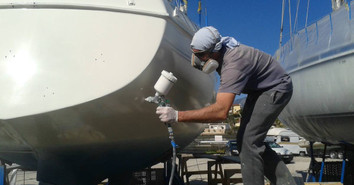There’s nothing like the joy of cutting through the water with a vessel that looks as good as it performs! However, maintaining that pristine appearance can be challenging. Exposure to sun, salt water, or lake water, as well as general wear can leave your boat’s paint looking dull.
These must-know tips for restoring your boat’s paint will have it looking like new in no time. We’ll cover everything you need to know, from preparation to polish, so your boat turns heads on every voyage.
1. Assessing the Condition of Your Boat’s Paint
First, evaluate the condition of the paint. Look for signs of oxidation, fading, and peeling. Oxidation appears as chalky, white patches, indicating that the paint has started to break down.
Fading is often the result of prolonged sun exposure, while peeling suggests the paint layers are separating from the hull. Identifying these issues will help you determine the necessary level of restoration.
2. Gathering the Right Supplies
Successful paint restoration starts with gathering tools and materials. You’ll need a high-quality marine cleaner to remove grime, sandpaper of varying grits for smoothing surfaces, and a reliable primer to prepare the boat for painting.
Additionally, investing in high-quality marine coatings is the key to getting long-lasting results. Don’t forget safety gear like gloves, goggles, and masks to protect yourself!
3. Cleaning and Prepping the Surface
Thoroughly clean the boat’s exterior to remove dirt, algae, and salt deposits. Use a marine cleaner and a soft-bristle brush to scrub the surface. Then, rinse the vessel thoroughly with fresh water and allow it to dry completely. This step ensures no contaminants interfere with the sanding and painting processes.
4. Applying the Marine Coating
Once you’ve prepared your boat by cleaning and sanding, it’s time to apply the marine coating. This step provides a protective barrier against the marine environment. Start with a high-quality marine primer, which will serve as the foundation for the top coat. The primer enhances adhesion and ensures the paint bonds well with the boat’s surface.
Once the primer is dry, apply the marine paint in even, overlapping strokes to avoid streaking and ensure full coverage. You may need to apply multiple coats, depending on the paint you choose.
5. Conducting Routine Maintenance
Maintaining your boat’s paint is an ongoing process. Regular washing, polishing, and touch-ups will keep your boat looking its best. Store your vessel in a shaded area whenever you pull it from the water, or use a cover to protect it from the elements. By investing time in routine maintenance, you’ll extend the life of the paint job and ensure your boat looks pristine.
Give Your Boat a Professional Finish
Restoring your boat’s paint is a fulfilling project that enhances both its appearance and longevity. With these tips, you can achieve a stunning finish that rivals professional work!

